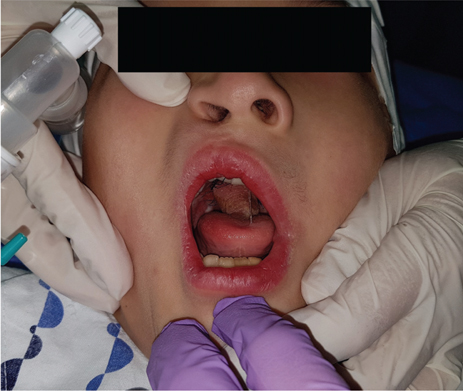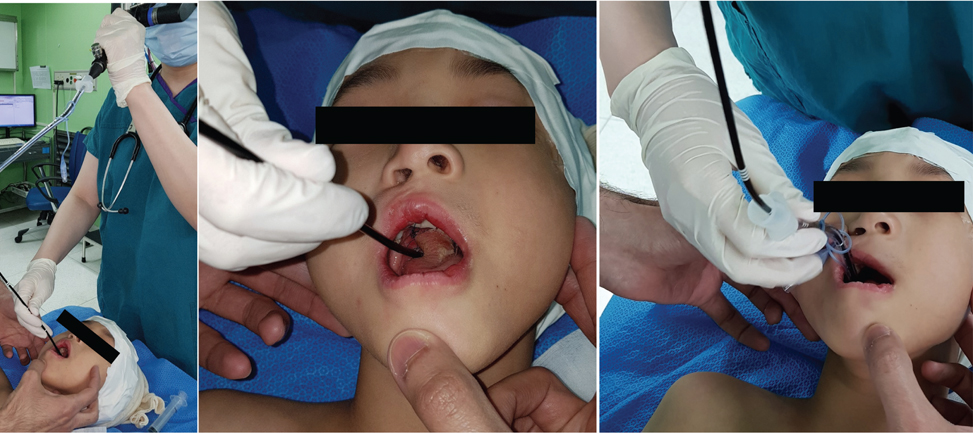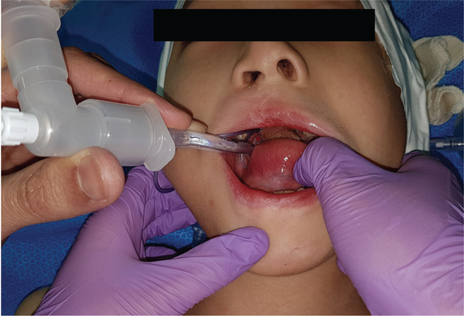J Dent Anesth Pain Med.
2018 Oct;18(5):309-313. 10.17245/jdapm.2018.18.5.309.
Airway management in pediatric tongue flap division for oronasal fistula closure: A case report
- Affiliations
-
- 1Department of Dental Anesthesiology, Seoul National University Dental Hospital, Seoul, Korea.
- 2Department of Dental Anesthesiology, Seoul National University, School of Dentistry, Seoul, Korea. stone90@snu.ac.kr
- 3Department of Oral and Maxillofacial Surgery, Seoul National University Dental Hospital, Seoul, Korea.
- KMID: 2424373
- DOI: http://doi.org/10.17245/jdapm.2018.18.5.309
Abstract
- Oronasal fistulae (ONF) could remain after surgery in some patients with cleft palate. ONF ultimately requires intraoral surgery, which may lead to perioperative airway obstruction. Tongue flap surgery is a technique used to repair ONF. During the second surgery for performing tongue flap division, the flap transplanted from the tongue dorsum to the palate of the patient acts as an obstacle to airway management, which poses a great challenge for anesthesiologists. In particular, anesthesiologists may face difficulty in airway evaluation and patient cooperation during general anesthesia for tongue flap division surgery in pediatric patients. The authors report a case of airway management using a flexible fiberoptic bronchoscope during general anesthesia for tongue flap division surgery in a 6-year-old child.
Keyword
MeSH Terms
Figure
Reference
-
1. Dixon MJ, Marazita ML, Beaty TH, Murray JC. Cleft lip and palate: Understanding genetic and environmental influences. Nat Rev Genet. 2011; 12:167–178.
Article2. Sahoo NK, Desai AP, Roy ID, Kulkarni V. Oro-nasal communication. J Craniofac Surg. 2016; 27:e529–e533.
Article3. Agrawal K. Cleft palate repair and variations. Indian J Plast Surg. 2009; 42:Suppl. S102–S109.
Article4. Guzel MZ, Altintas F. Repair of large, anterior palatal fistulas using thin tongue flaps: Long-term follow-up of 10 patients. Ann Plast Surg. 2000; 45:109–114.
Article5. Sadhu P. Oronasal fistula in cleft palate surgery. Indian J Plast Surg. 2009; 42:Suppl. S123–S128.
Article6. Hochberg J, Naidu R, Saunders DE. Anesthesia technique for serving the pedicle of a tongue flap in the presence of a pharyngeal flap. Plast Reconstr Surg. 1978; 62:905–906.
Article7. Peter S, Subash P, Paul J. Airway management during second-stage tongue flap procedure. Anesth Analg. 2007; 104:217.
Article8. Fung BK, Chan MY. Incidence of oral tissue trauma after the administration of general anesthesia. Acta Anaesthesiol Sin. 2001; 39:163–167.9. Gopinath VK, Muda WA. Assessment of growth and feeding practices in children with cleft lip and palate. Southeast Asian J Trop Med Public Health. 2005; 36:254–258.10. Rohrich RJ, Love EJ, Byrd HS, Johns DF. Optimal timing of cleft palate closure. Plast Reconstr Surg. 2000; 106:413–421.
Article11. Phero JC, Rosenberg MB, Giovannitti JA Jr. Adult airway evaluation in oral surgery. Oral Maxillofac Surg Clin North Am. 2013; 25:385–399.
Article12. Frerk C, Mitchell VS, McNarry AF, Mendonca C, Bhagrath R, Patel A, et al. Difficult airway society 2015 guidelines for management of unanticipated difficult intubation in adults. Br J Anaesth. 2015; 115:827–848.
Article13. Solan KJ. Nasal intubation and previous cleft palate repair. Anaesthesia. 2004; 59:923–924.
Article14. Sahoo TK, Ambardekar M, Patel RD, Pandya SH. Airway management in a case of tongue flap division surgery: A case report. Indian J Anaesth. 2009; 53:75–78.15. Eipe N, Pillai AD, Choudhrie A, Choudhrie R. The tongue flap: An iatrogenic difficult airway? Anesth Analg. 2006; 102:971–973.
Article16. Kameyama K, Watanabe S, Kano T, Kusukawa J. Effects of nasal application of an epinephrine and lidocaine mixture on the hemodynamics and nasal mucosa in oral and maxillofacial surgery. J Oral Maxillofac Surg. 2008; 66:2226–2232.
Article17. Andrews JI, Kumar N, van den Brom RH, Olkkola KT, Roest GJ, Wright PM. A large simple randomized trial of rocuronium versus succinylcholine in rapid-sequence induction of anaesthesia along with propofol. Acta Anaesthesiol Scand. 1999; 43:4–8.
Article18. Sorensen MK, Bretlau C, Gatke MR, Sorensen AM, Rasmussen LS. Rapid sequence induction and intubation with rocuronium-sugammadex compared with succinylcholine: A randomized trial. Br J Anaesth. 2012; 108:682–689.
Article
- Full Text Links
- Actions
-
Cited
- CITED
-
- Close
- Share
- Similar articles
-
- Oronasal fistula reconstruction using tongue flap with simultaneous iliac bone graft: a case report
- A Comparison of Anterior Based with Posterior Based Tongue Flaps for the Closure of Palatal Fistulas
- A Case of Oronasal Fistula Repaired With Inferior Turbinate Rotational Flap
- A novel modification of Bardach’s two-flap palatoplasty for the repair of a difficult cleft palate
- Total Tongue Reconstruction with Folded Anterolateral Thigh Free Flap




